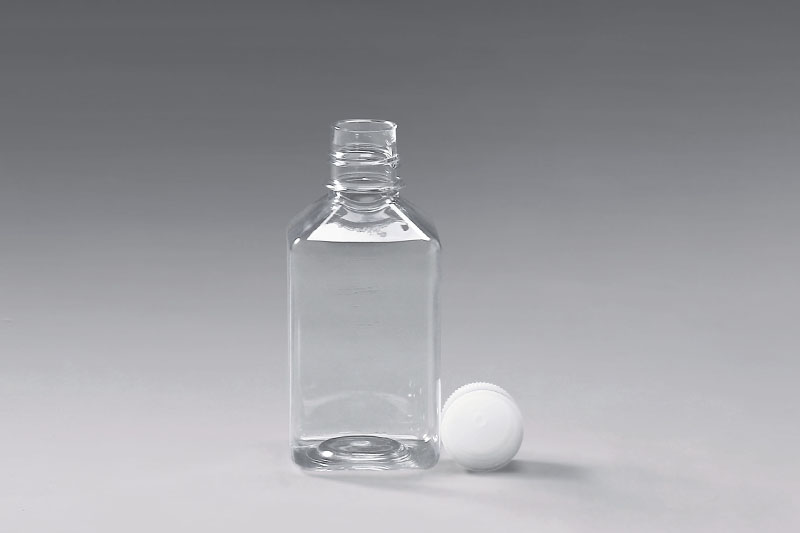The square culture media bottle is a special container for holding the culture medium. It is generally made of transparent PET/PETG material through the injection, stretch and blow process. The quality of the bottle is very important for the storage of the culture medium. What is the production process of this container?
In the production process of square culture media bottles, the whole blowing process can be divided into four stages: stretching, pre-blowing, blowing and cooling. When the temperature adjustment process is completed, the mold is closed, and the stretching rod moves downward to stretch the preform down along the axis direction. The lowering speed of the stretching rod is controlled by the stretching cam. The material distribution of the bottle along the axis direction is formed at this moment. The stretching speed is one of the key parameters affecting the material distribution in the axis direction. If it is too fast, the material at the bottom of the bottle is likely to be too much, resulting in insufficient material distribution in the upper part of the bottle, the overall mechanical properties are reduced. Of course if it is too slow. Then the material at the bottom of the bottle is easy to be too small, which will also lead to the decline of the overall mechanical properties, and the ideal bottle cannot be blown.
The function of pre-blowing is to ensure that a certain distance is always maintained between the preform material and the stretching rod during the stretching process, so as to avoid contact between the preform wall and the stretching rod. During the stretching process, if there is contact between the preform and the stretching rod, the material will be cooled by the stretching rod, and the friction of the stretching rod and the adhesion of the hot PET/PETG material will cause the contacted part Couldn't be stretched as expected and could't blow out a good bottle. So the pre-blowing process is very important. The pre-blowing pressure and time settings are critical. The pre-blowing pressure is generally adjusted at about 6-10 bar. If the pre-blowing is not enough, the purpose of separating the stretch rod and the bottle wall material will not be achieved. If the pre-blowing is too much, the bottle wall material will not be fully stretched. In a good case, the inner wall of the mold is contacted in advance, which will also affect the distribution of the material in the height direction, and the expected material distribution cannot be achieved.
The above is the production process of the square culture media bottles. This production process can effectively utilize the heat retained in the injection molding process of the preform, so that the energy consumption will be greatly reduced. Effectively avoid the phenomenon of friction marks on the bottle mouth or bottle body in other production processes, and the produced bottles have high quality.
The FAI climbed 5.9 percent year-on-year in the first 11 months of 2018, quickening from the 5.7-percent growth in Jan-Oct, the National Bureau of Statistics (NBS) said Friday in an online statement.
The key indicator of investment, dubbed a major growth driver, hit the bottom in August and has since started to rebound steadily.
In the face of emerging economic challenges home and abroad, China has stepped up efforts to stabilize investment, in particular rolling out measures to motivate private investors and channel funds into infrastructure.
Friday's data showed private investment, accounting for more than 60 percent of the total FAI, expanded by a brisk 8.7 percent.
NBS spokesperson Mao Shengyong said funds into weak economic links registered rapid increases as investment in environmental protection and agriculture jumped 42 percent and 12.5 percent respectively, much faster than the average.
In breakdown, investment in high-tech and equipment manufacturing remained vigorous with 16.1-percent and 11.6-percent increases respectively in the first 11 months. Infrastructure investment gained 3.7 percent, staying flat. Investment in property development rose 9.7 percent, also unchanged.
 English
English



















































